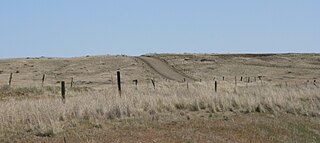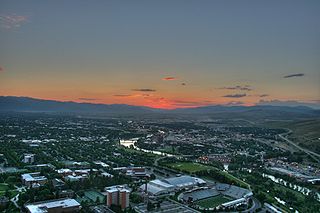
Missoula is a city in and the county seat of Missoula County, Montana, United States. It is located along the Clark Fork River near its confluence with the Bitterroot and Blackfoot rivers in western Montana and at the convergence of five mountain ranges, and thus it is often described as the "hub of five valleys". The 2020 United States census recorded the city's population at 73,489 and the population of the Missoula Metropolitan Area at 117,922. As of 2023, the estimated city population was 77,757. Missoula is the second largest city and metropolitan area in Montana. Missoula is home to the University of Montana, a public research university.
Venus Alley was a famous red-light district once located in Butte, Montana in the United States. It flourished from the late 19th century through the early 20th century and was one of the last openly tolerated urban prostitution districts in the American West, along with the one in Reno, Nevada. It was closed in the 1970s.

Maggie Hall was a prostitute and brothel madam in the early history of Murray, Idaho, originally from Dublin, Ireland. In local lore she is known as a "Prostitute with a heart of gold" and the "Patron Saint of Murray".

Mullan Road was the first wagon road to cross the Rocky Mountains to the Inland of the Pacific Northwest. It was built by U.S. Army troops under the command of Lt. John Mullan, between the spring of 1859 and summer 1860. It led from Fort Benton, which at the time was in the Dakota Territory, then Idaho Territory from July 1863, and into Montana Territory beginning in May 1864. The road eventually stretched all the way from Fort Walla Walla, Washington Territory, near the Columbia River to the navigational head of the Missouri River, which at the time was the farthest inland port in the world). The road previewed the route approximately followed by modern-day Interstate 15 and Interstate 90 through present-day Montana, Idaho, and Washington.

Pearl de Vere, known as the "soiled dove of Cripple Creek", was a 19th-century prostitute and madam, and owner of one of the most famed and exclusive brothels in the American Old West.

The Milwaukee Depot in Missoula, Montana, was built by the Chicago, Milwaukee, St. Paul and Pacific Railroad in 1910 as part of the railroad's transcontinental "Pacific Extension".

Josephine "Chicago Joe" Airey, was an Irish-born American prostitute, madam, and proprietor of brothels, dance halls, a variety theatre, and saloons in Helena, Montana. She eventually became the most influential landowner in Helena. She was known as "Chicago Joe" Hensley following her marriage to James T. Hensley.

Hauser Dam is a hydroelectric straight gravity dam on the Missouri River about 14 miles (23 km) northeast of Helena, Montana, in the United States. The original dam, built between 1905 and 1907, failed in 1908 and caused severe flooding and damage downstream. A second dam was built on the site in 1908 and opened in 1911 and comprises the present structure. The current Hauser Dam is 700 feet (210 m) long and 80 feet (24 m) high. The reservoir formed by the dam, Hauser Lake, is 25 miles (40 km) long, has a surface area of 3,800 acres (1,500 ha), and has a storage capacity of 98,000 acre-feet (121,000,000 m3) of water when full.

Downtown Missoula is the central business district in Missoula, Montana, and West-Central Montana. Downtown Missoula's rough boundaries are the Clark Fork River to its south, Madison St. to its east, the old U.S 93 highway/ North Orange St. to its west, and West Alder St. to its north, though parts south of the Clark Fork River are also at times mentioned. It is home to Ogren Park at Allegiance Field which is the venue for the Missoula PaddleHeads. Downtown is also home to several parks, and historic buildings such as the Wilma Building.

Missoula Cemetery is the second oldest cemetery located in Missoula, Montana, with Fort Missoula Cemetery being the oldest. The Missoula Cemetery was first established in 1884 by the Missoula Valley Improvement Company, a corporation owned by prominent citizens Isadore Cohn, Frank Woody, William H.H. Dickinson and Thomas C Marshall. The land where the cemetery would be built was purchased from the Northern Pacific Railroad for $168. The cemetery was eventually sold to the City of Missoula in 1901, for the total of $1.

The history of Missoula, Montana begins as early as 12,000 years ago with the end of the region's glacial lake period with western exploration dating back to the Lewis and Clark Expedition of 1804–1806. The first permanent settlement was founded in 1860.

Capt. Christopher Powers Higgins was an American Army captain and later businessman who with Frank Worden founded the Hellgate Trading Post and the nearby city of Missoula, Montana. He erected one of the first lumber and flouring mills on the Clark Fork River near present Downtown Missoula as well as many of Missoula's first buildings and establishments. He was one of the original county commissioners, member of first legislature of the Montana Territory, and incorporator of The Montana Historical Society. Higgins Avenue and bridge as well as the Higgins block in Downtown Missoula are named after him. He is buried in Missoula Cemetery.

Dorothy Josephine Baker, also known as Big Dorothy, was an American madam in Helena, Montana in the mid-20th century. She ran a brothel officially known as "Dorothy's Rooms" on Last Chance Gulch in Helena from the mid-1950s until it was shut down in a police raid in 1973. While running the brothel, she also donated to many charities, including churches and law enforcement programs, making her generally popular among the local citizens.
This is a timeline of pre-statehood Montana history comprising substantial events in the history of the area that would become the State of Montana prior to November 8, 1889. This area existed as Montana Territory from May 28, 1864, until November 8, 1889, when it was admitted to the Union as the State of Montana.

The Missoula station in Missoula, Montana, was built by the Northern Pacific Railway in 1901. The current structure is the third depot built in Missoula by the Northern Pacific, which reached Missoula in 1883. It was listed on the National Register of Historic Places in 1985, as the Northern Pacific Railroad Depot.

The Star is a historic commercial building at 5 Creek Street in Ketchikan, Alaska, United States. It is the only one of a once-numerous collection of brothels that famously lined Creek Street to retain its historical integrity, and was one of the largest in the city.

The Dumas Brothel was a brothel in Butte, Montana. The brothel was founded by French-Canadian brothers Joseph and Arthur Nadeau in 1890 and named after the nominal owner, Delia Nadeau, née Dumas, who was Joseph's wife. It grew considerably through the years, with the miners employed by the city's copper mines often patronizing the establishment. After several changes of the "madams" and continuing pressure from authorities, the brothel closed in 1982, described as "a rare, intact commentary on social history". At the time of its closure, it was the longest operating brothel in the United States, having operated years after prostitution was made illegal. After closing, the brothel changed hands several times, eventually becoming a tourist attraction owned and managed by a series of Butte residents.

Laura Bell McDaniel was an American madam and brothel owner in Colorado City, now called Old Colorado City, and Cripple Creek during the late 19th century and early 20th century. She was also known the "Courtesan of Colorado City" and "Queen of the Colorado City Tenderloin". She had entered the profession after being left with an infant daughter. McDaniel maintained a close relationship with her mother and family over her career and she sent her daughter to boarding school. Her clients were among the wealthy citizens of the Colorado Springs area and she was said to have the "most spectacular [house] in town", managed by a number of servants. Although she was encouraged to leave town by citizens and law enforcement, she continued to operate her business until her death.

Mary Gleim was the leading and most successful madam in the Old West days of Missoula, Montana, owning eight brothels in 1890.




















